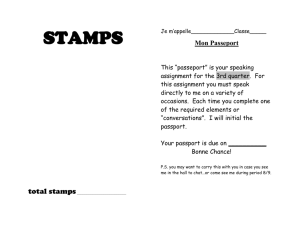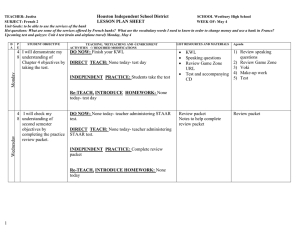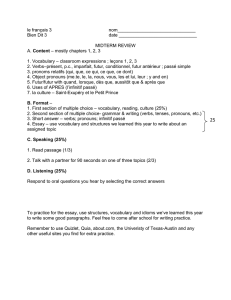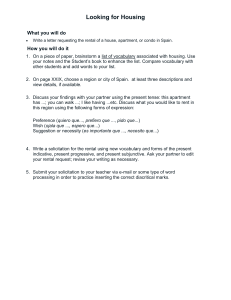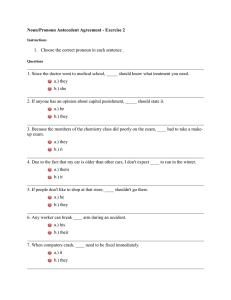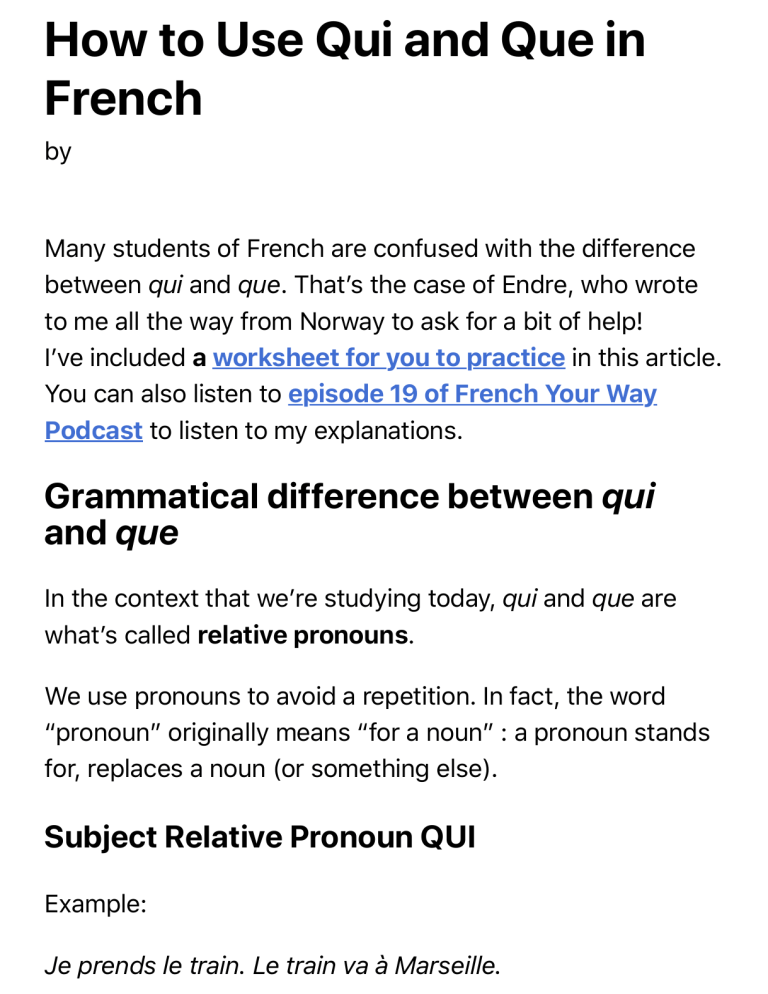
How to Use Qui and Que in French by Many students of French are confused with the difference between qui and que. That’s the case of Endre, who wrote to me all the way from Norway to ask for a bit of help! I’ve included a worksheet for you to practice in this article. You can also listen to episode 19 of French Your Way Podcast to listen to my explanations. Grammatical difference between qui and que In the context that we’re studying today, qui and que are what’s called relative pronouns. We use pronouns to avoid a repetition. In fact, the word “pronoun” originally means “for a noun” : a pronoun stands for, replaces a noun (or something else). Subject Relative Pronoun QUI Example: Je prends le train. Le train va à Marseille. (= I’m taking the train. The train is going to Marseilles.) In order to avoid repeating « le train », it’s better to use a pronoun. The first sentence (je prends le train) doesn’t really interest us because it’s the second time the word “train” appears that you want to change (the first time, it’s not a repetition) so let’s look at the 2nd sentence (“Le train va à Marseille). In that sentence, “le train” is the subject. 1. You can say : Je prends le train. Il va à Marseille. (= I’m taking the train. It is going to Marseilles.) → If you do this, you’ve used a simple subject pronoun “il”. You already know the subject pronouns. They are: je, tu, il, elle, on, nous, vous, ils, elles (i.e the ones you use to conjugate a verb). 2. We can also decide to create one single sentence out of the two. To do this, we’ll use a relative pronoun : relative pronouns allow to avoid a repetition AND combine two sentences in one. The relative pronoun that is also a subject pronoun is QUI. Je prends le train. Le train va à Marseille. Je prends le train qui va à Marseille. (= I’m taking the train which is going to Marseilles.) Another example : Je regarde la jeune fille. La jeune fille marche sur la plage. (= I’m looking at the young girl. The young girl is walking on the beach.) In the second sentence, « la jeune fille » (which is the repeated element) is the subject. Je regarde la jeune fille. Elle marche sur la plage. (= I’m looking at the young girl. She‘s walking on the beach.) → simple use of the subject pronoun. or Je regarde la jeune fille qui marche sur la plage. (=I’m looking at the young girl who is walking on the beach.) → use of the subject relative pronoun QUI to create a single sentence. Direct Object Relative Pronoun QUE Example: Le train va à Marseille. Je prends le train. (= The train is going to Marseilles. I’m taking the train.) Let’s use a pronoun to avoid repeating « le train ». In the second occurrence / sentence, “le train” is the direct object (It’s not the subject , it’s not doing the action. The subject is “je”). 1. You can say : Le train va à Marseille. Je le prends. (= the train is going to Marseilles. I’m taking it.) → If you do this, you’ve used the direct object pronoun (“le”). 2. If we want to create one single sentence, the relative pronoun that is also a direct object pronoun is QUE. Le train que je prends va à Marseille. (= The train that I’m taking is going to Marseilles.) Note: Every relative pronoun (and the clause/sentence going with it) needs to be placed immediately after the word(s) it replaces, otherwise it can be confusing to know what this pronoun refers to. In our example, we need to insert the insert “que je prends” (which was made from the second sentence) right after “le train”. Le train [QUE je prends] va à Marseille. It works the same as in English (= The train that I’m taking is going to Marseilles). I you said “the train is going to Marseilles that I’m taking”, we would think you were taking Marseilles – which wouldn’t make much sense! Another example : La jeune fille marche sur la plage. Je regarde la jeune fille. (= The young girl is walking on the beach. I’m looking at the young girl.) In the second sentence, « la jeune fille » (which is the repeated element) is the direct object. La jeune fille marche sur la plage. Je la regarde . (= The young girl is walking on the beach. I’m looking at her.) → simple use of a direct object pronoun. or La jeune fille que je regarde marche sur la plage. (The young girl whom I’m looking at is walking on the beach.) → use of the subject relative pronoun to create a single sentence. Note : insert “que je regarde” right after “la jeune fille». « La jeune fille marche sur la plage que je regarde » would mean that you’re looking at the beach ! Tip to choose between qui and que quickly! Alright ? Now, that was for the formal difference between qui and que. I believe it is very important to analyse and understand how the structure of a language works (I’ve already explained why here in my article : “Challenge: Can I make you love French Grammar?”) If grammar is not your forte, here’s a simple tip for you: to decide between qui and que, pay attention to the structure of the sentence: “qui” is a subject, it will therefore be followed by the verb. QUI + VERB Je prends le train QUI VA à Marseille. Je regarde la jeune fille QUI MARCHE sur la plage. « que » is a direct object, so the sentence will also need to have a subject. The structure will therefore be: QUE + SUBJECT + VERB Le train QUE JE PRENDS va à Marseille. La jeune fille QUE JE REGARDE marche sur la plage. Ce qui, Ce que Ce qui and ce que can both be translated by « what » in English. Use the tip described above to decide between using ce qui (ce QUI+ VERB) and ce que (ce QUE+ SUBJECT + VERB). Why start a sentence with ce qui / ce que ? We use this to put the emphasis on something, to make it stand out by creating a bit of suspense/anticipation. Example #1: La langue m’intéresse. (= The language interests me) → neutral statement. Ce qui m’intéresse, c’est la langue. (= What interests me is the language.) →suspense then answer in the second part of the sentence. Note: in the original sentence (“La langue m’intéresse »), « la langue » is the subject. That explains why we use « ce QUI ». Example #2 Je veux être trilingue. (= I want to be trilingual.) Ce que je veux, c’est être trilingue. (= What I want is to be trilingual) →suspense then answer in the second part of the sentence. Note: in the original sentence (“Je veux être trilingue»), « être trilingue » is the direct object of the verb “vouloir”/”je veux”. That explains why we use « ce QUE »! Let me know in the comment section if you have more questions about the use of qui and que! To test yourself, try the exercises I’ve prepared for you in this free worksheet! Get Worksheet

